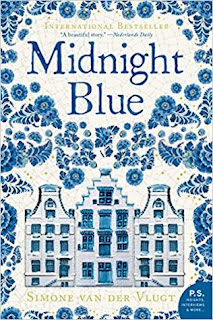Midnight Blue by Simone Van Der Vlugt
This story is set during the 17th century Netherlands, period known as the Dutch Golden Age, and during that time art was among the most acclaimed in the world. The story briefly weaves in such artists as Rembrandt and Vermeer, focusing majorly on the Dutch Porcelain.
It starts in 1654 in a small village of De Rijp. The fictional heroine, Catrin, after the death of her husband, moves out of her village, which is unheard of. She follows her dream to be in a city. She sells all her belongings and the only thing she takes with her is the talent for painting. She dreams of having her own business of painting pottery.
In Amsterdam, Catrin takes a job as a housekeeper to the successful Van Nulandt merchant family. As a merchant he trades with China, bringing exquisite porcelain. No one in Europe knows how to make it. And what catches Catrin’s eye are the figures and landscape painted on big vases. But when the past catches up with her, she moves to Delft with recommendations from Van Nulandt’s.
In Delft, she gets her dream job as pottery painter. Van Nulandt’s father started working with majolica – “rough earthenware with an ornamental glaze that originated in Italy.” His oldest son who took over the business shifted to faience – “a finer type of earthenware,” something of porcelain, but not so delicate. Catrin is introduced to the pottery when it is already in decline. An idea comes to her mind to introduce new motifs, not just the flowers that have been painted thousands of times already. She convinces her boss to try something new. She draws first Chinese figures and landscape, which later are copied on thousands of pottery. A revival starts, giving birth to Dutch Porcelain, later it was named Delftware or Delft pottery, also known as Delft Blue.
The story also intertwines the Delft Explosion of 1654, gunpowder explosion caused by an inspector with a lantern. As well as 1655 plague; as with any previous epidemic that ravaged Europe, this one is no exception, leaving thousands dead.
There is one part of the story, something in Catrin’s past which follows her throughout the story. I didn’t care for this part and I think the story would have been even stronger without it. But at the same time, I can see how this could be a great hook for others. Overall, it is an interesting story, reviving the Dutch Porcelain in history.
@Facebook/BestHistoricalFiction
It starts in 1654 in a small village of De Rijp. The fictional heroine, Catrin, after the death of her husband, moves out of her village, which is unheard of. She follows her dream to be in a city. She sells all her belongings and the only thing she takes with her is the talent for painting. She dreams of having her own business of painting pottery.
In Amsterdam, Catrin takes a job as a housekeeper to the successful Van Nulandt merchant family. As a merchant he trades with China, bringing exquisite porcelain. No one in Europe knows how to make it. And what catches Catrin’s eye are the figures and landscape painted on big vases. But when the past catches up with her, she moves to Delft with recommendations from Van Nulandt’s.
In Delft, she gets her dream job as pottery painter. Van Nulandt’s father started working with majolica – “rough earthenware with an ornamental glaze that originated in Italy.” His oldest son who took over the business shifted to faience – “a finer type of earthenware,” something of porcelain, but not so delicate. Catrin is introduced to the pottery when it is already in decline. An idea comes to her mind to introduce new motifs, not just the flowers that have been painted thousands of times already. She convinces her boss to try something new. She draws first Chinese figures and landscape, which later are copied on thousands of pottery. A revival starts, giving birth to Dutch Porcelain, later it was named Delftware or Delft pottery, also known as Delft Blue.
The story also intertwines the Delft Explosion of 1654, gunpowder explosion caused by an inspector with a lantern. As well as 1655 plague; as with any previous epidemic that ravaged Europe, this one is no exception, leaving thousands dead.
There is one part of the story, something in Catrin’s past which follows her throughout the story. I didn’t care for this part and I think the story would have been even stronger without it. But at the same time, I can see how this could be a great hook for others. Overall, it is an interesting story, reviving the Dutch Porcelain in history.
@Facebook/BestHistoricalFiction

Comments
Post a Comment